#sir christopher wren
Explore tagged Tumblr posts
Photo
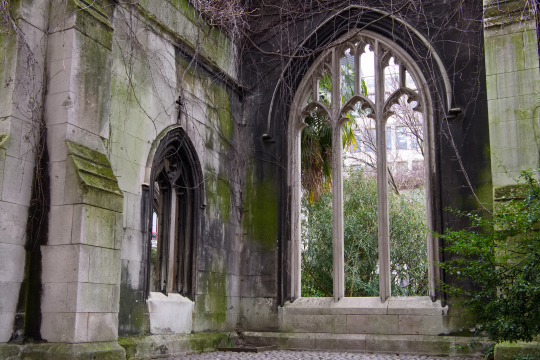
Another view of the ruined St Dunstan in the East Church
Notwithstanding that the church is in the heart of the City of London and surrounded by tall offices, it almost feels like nature is taking over
#London#church#ruined#abandoned#city of london#nature#st dunstan in the east#ruins#window#arched#sir christopher wren#England#UK
259 notes
·
View notes
Video
St Paul's Cathedral London by Roy Llowarch Via Flickr: Trip round St Paul's Cathedral London. Amazing building not allowed to take photos inside for some strange reason but took one photo of Lord Nelson's Tomb and the Duke Of Wellington's Tomb. en.wikipedia.org/wiki/St_Paul%27s_Cathedral
#St Paul's#St Paul#Cathedral#Cathedrals#St Paul's London#Churches#Church#Church Of England#Wellington#Nelson#Lord Nelson#Admiral Nelson#Vice Admiral Nelson#Admiral Viscount Nelson#Duke Of Wellington#The Iron Duke#Iron Duke#Arthur Wellesley#Sir Christopher Wren#English Baroque#Architecture#England#English History#English#English Heritage#English Churches#British History#British Heritage#British Churches#heritage
3 notes
·
View notes
Text
Like a timeless ship of state, St Paul's presides over a rebuilt London

London, UK 🇬🇧
#St Paul's Cathedral#London#English cathedrals#18th century#UK#neo-classical#aerial photography#Sir Christopher Wren#Church of England#urban landscape#timeless#evening light
760 notes
·
View notes
Text
Discovering the Bones of the Missing Princes in the Tower: A Guest Post by Elizabeth St.John
The inspiration for The King’s Intelligencer grew from my research for The Godmother’s Secret, which focuses on the enduring mystery of the missing princes in the Tower of London. Edward V and Richard, Duke of York, disappeared in 1483, with many believing they were murdered by their uncle, Richard III. This historical enigma has intrigued scholars and writers for centuries, and I found myself…
#Charles II#Elizabeth St.John#Richard III#Sir Christopher Wren#The Princes in the Tower#Tower of London#Westminster Abbey
0 notes
Text
26th February
Sir Christopher Wren
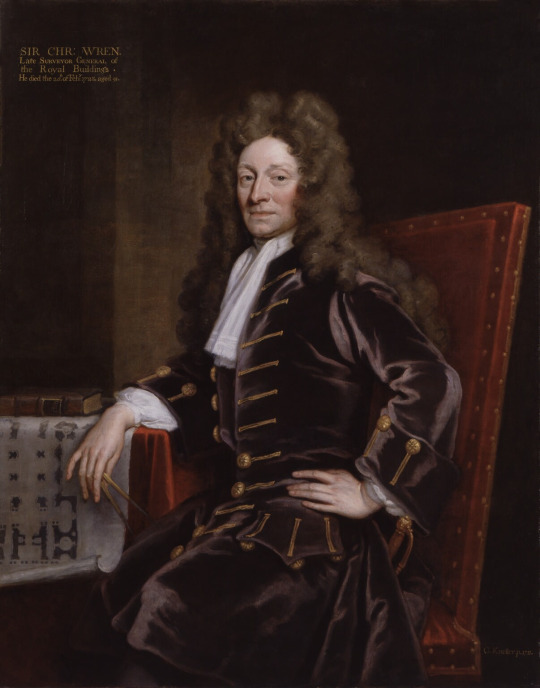
Wren in a portrait by Godfrey Kneller (1711). Source: Wikipedia
Sir Christopher Wren died on this day in 1723 in the Old Court House of London. Every year Wren’s ghost appears on the anniversary of his death and glides through the first floor dining room of the House. His hands allegedly brush the walls and he seems also on occasion to convene a group of phantoms because the stairs leading to the dining room creak and echo with the sound of ghostly footsteps for most of the day. The Old Court House was not simply the location of Wren’s deathbed, it is also where he stayed when supervising the construction of Hampton Court, so his supernatural attachment to the place is understandable.
0 notes
Text
Sir Christopher Wren
Sir Christopher Wren died 300 years ago on 8 March 1723. The Folly Flâneuse thought she would mark the anniversary by looking at a two examples of his work that served as garden ornaments – once surplus to their original requirements. (more…) “”
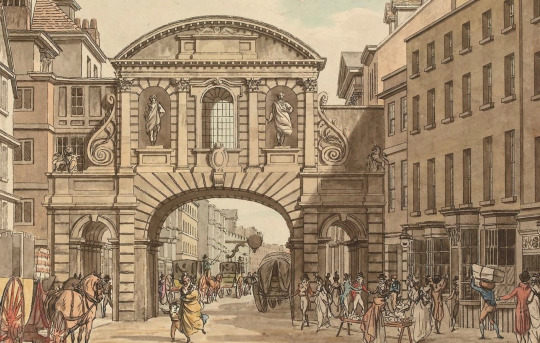
View On WordPress
#City of London#Lady Meux#Paternoster Square#Robert Harrild#Seely & Paget#Sir Christopher Wren#Sir Henry Bruce Meux#St Antholin#Sydenham#Temple Bar#Theobalds
0 notes
Text
The dazzling inner dome of Wren's masterpiece, St Paul's Cathedral

📍St. Paul's Cathedral, London, England, United Kingdom 🇬🇧
#St Paul's Cathedral#Church of England#Sir Christopher Wren#London#English cathedrals#baroque#classical architecture#sacred space#lantern#17th century#Christendom#UK
319 notes
·
View notes
Text
Books On Books Collection - Stuart Whipps
Books On Books Collection – Stuart Whipps

View On WordPress
0 notes
Text
5 More Latin Phrases
to try to include in your poem/story (again)
Over the centuries, certain Latin phrases have been used widely enough in English to get included in the dictionary.
Aere Perennius
"More lasting than bronze"
In the final poem in his third book of Odes, Horace boasts that his poetry will outlive any manmade monument:
"Exegi monumentum aere perennius." ("I have made a monument more lasting than bronze.")
Given that his words continue to be used two thousand years later, perhaps he's right.
Caveat Emptor
"Let the buyer beware"
In early Roman law, sales of goods were governed by caveat emptor: buyers were advised to scrutinize the goods before purchase, because sellers had few obligations.
Over time, the imperative of caveat emptor has been softened by warranties, both express and implied.
Caveat has been adopted directly into English, and has a small range of meanings, including "a warning enjoining one from certain acts or practices" and "an explanation to prevent misinterpretation."
Emptor has likewise been taken directly into the English language, although the word is far less common than caveat; it has retained the rather narrow meaning of "buyer, purchaser."
Per Angusta Ad Augusta
"Through difficulties to honors"
These four words have inspired students and soldiers for centuries.
Alternative translations include "through trial to triumph" and "through difficulties to great things."
Post Hoc, Ergo Propter Hoc
"After this, therefore on account of it"
This refers to the logical mistake of claiming that one thing caused another just because it happened first.
For example, the rooster crows and the sun rises - but to argue that the rooster's crowing causes the sun to rise would be post hoc, ergo propter hoc reasoning.
It was Aristotle who laid the groundwork for classifying bad arguments based on logical errors like this one.
Si Monumentum Requiris, Circumspice
"If you seek his monument, look around"
It took 35 years to complete London's magnificent St. Paul's Cathedral.
When its architect, Sir Christopher Wren, died twelve years later in 1723, he was entombed inside, under a simple slab of black marble.
Wren's son placed a dedication nearby, which contains the words "Lector, si monumentum requiris, circumspice" ("Reader, if you seek a monument, look around you").
The phrase is generally used to describe a person's legacy - and can be taken to mean that what we leave behind (including intangible things like relationships) best represents our life.
If any of these phrases make their way into your next poem/story, please tag me, or leave a link in the replies. I would love to read them!
Latin Phrases pt. 1
#writing prompt#writeblr#spilled ink#writers on tumblr#poets on tumblr#literature#poetry#words#lit#writing challenge#latin#langblr#studyblr#dark academia#writing tips#writing inspo#writing ideas#writing inspiration#writing reference#writing resources
113 notes
·
View notes
Text
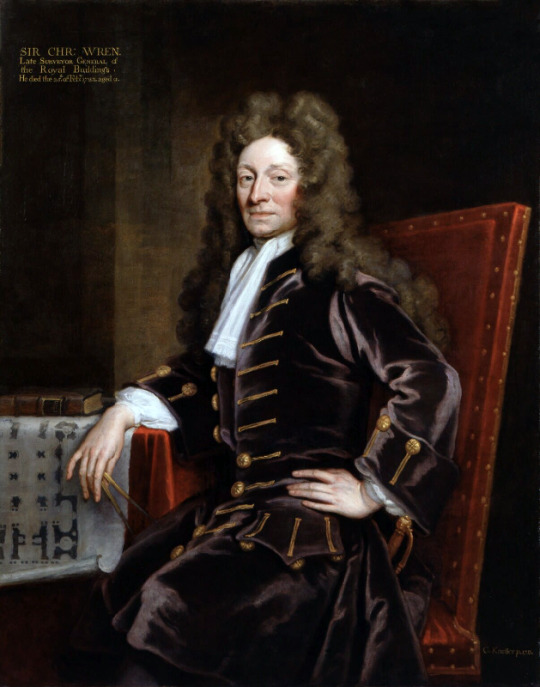
1711 Godfrey Kneller - Sir Christopher Wren
(National Portrait Gallery, London)
94 notes
·
View notes
Text
One of Christopher Wren's most famous churches & sacred spaces

St. Martin-in-the-Fields church at Trafalgar Square photographed here in 1967.
#St Martin-in-the-Fields#Trafalgar Square#Sir Christopher Wren#Wren churches#Church of England#London#choral music#baroque style#classical architecture#sacred space#vintage
107 notes
·
View notes
Photo

An arch at St Dunstan in the East Church
This ruined church and its gardens can be found in the City of London and provides a peaceful sanctuary for city workers from the stresses of their offices, or at least it would do but for annoying instagrammers and probably the likes of me!
#London#church#ruined#abandoned#city of london#st dunstan in the east#ruins#arch#bench#sanctuary#wren#sir christopher wren#England#UK
222 notes
·
View notes
Text
The Painted Hall, Greenwich

During the king’s coronation I visited Greenwich's "Painted Hall." This series of rooms depict scenes relating to the success of British Protestantism and the beginning of burgeoning imperial expansion. Following the vital English naval victory over France at La Hougue in 1692, Queen Mary ordered that a hospital be built for retired seamen, in keeping with the existing hospital for former soldiers at Chelsea. While Mary died before its completion her husband, William III, saw the projected through. Sir Christopher Wren (of St Paul’s fame) and his assistant, Nicholas Hawksmoor, designed a grand series of buildings at Greenwich, in London. The Royal Hospital at Greenwich acted as a retirement home for sailors between the 1700s and late 1900s. And at its heart is the Painted Hall, a series of rooms where a relatively unknown artist, James Thornhill, was commissioned to paint scenes of British-Protestant triumph.
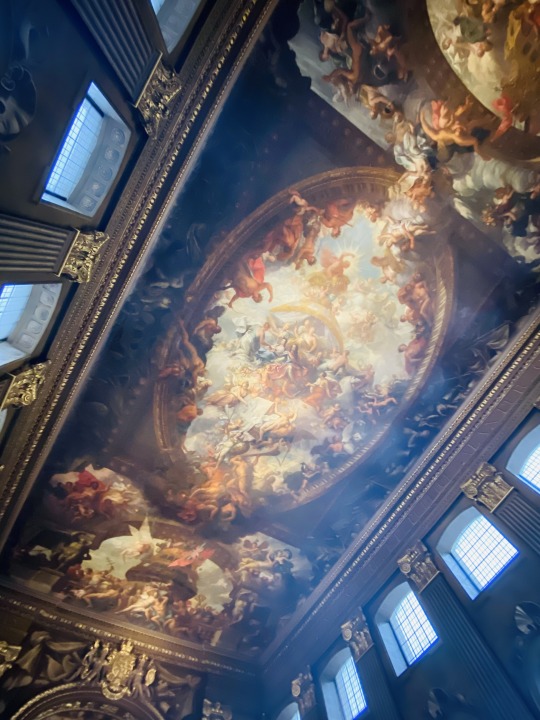
At the centre is King William III and Queen Mary shown overseeing ‘The Triumph of Peace and Liberty over Tyranny.’ Immediately above the couple and to their left is the allegorical figure of Prudence holding a mirror, one of the four Cardinal Virtues.

To her right are Providence and Concord, while to her left is Justice. Beneath Justice is a woman representing Europe, who is accepting the ‘cap of liberty,’ the ancient red Phrygian cap, from William, who in turn is accepting an olive branch from ‘Peace.’
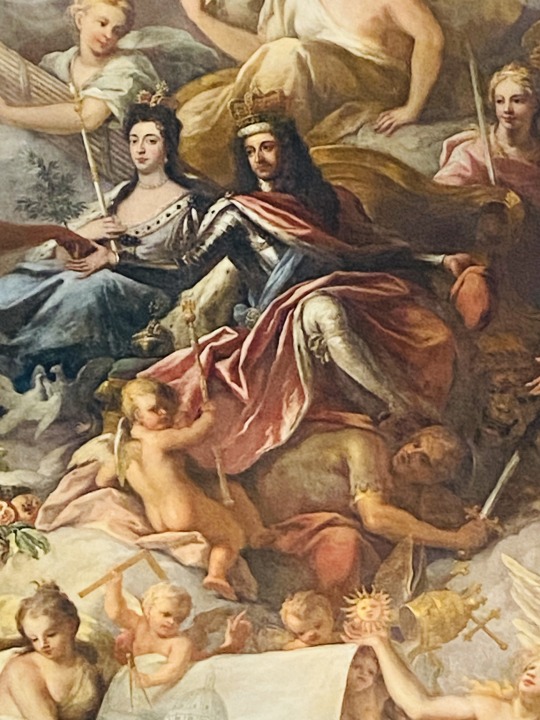
Beneath William’s foot is the defeated Louis XIV of France with a broken sword, and a tumbling, discarded papal crown. Beneath them the ‘Spirit of Architecture’ along with Truth and Time are overseeing plans showing the actual construction of the hospital.
Above it all, Apollo rides his chariot, while the signs of the zodiac are arrayed around the edges. At the bottom, Pallas Athena and Hercules crush the Hydra and the Gorgon, ‘expelling the Vices from the Kingdom of William and Mary.’

Another section of the ceiling shows a captured Spanish galley laden with the spoils of war, a reference to the British capture of Gibraltar in 1704. Diana, Goddess of the moon, passes mastery of the tides over to British sailors. Beneath them are representations of the English rivers Avon, Severn and Humber.
To the left and the right, scientific advancement is celebrated by the presence of astronomers Tycho Brahe, John Flamsteed, Copernicus and Newton’s ‘Principia.’ The gods Neptune and Cybele oversee it all.
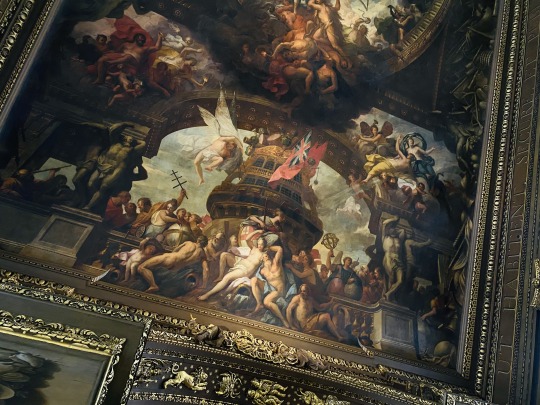
The next section of the ceiling shows HMS Blenheim being filled with the spoils of war by the winged figure of Victory. Beneath are more river representations along with the City of London and figures representing navigation and astronomy. On the left is Galileo, while Zeus and Juno watch from above.

The painted hall took decades to complete, and saw further dynastic change, as George I, originally of Hanover, became king after William III’s successor, Queen Anne, died. George maintained the Protestant ascendancy, as portrayed in the upper hall chamber adjoining the main hall.
Here we see George I, his wife Sophia of Hanover and their children and grandchildren beneath St Paul’s, overseen the a figure representing “the Golden Age” with overflowing cornucopia. The artist, James Thornhill, added himself on the right. Over them is an inscription quoting Virgil's Eclogues, which translates as ‘a new generation has descended from the heavens.’
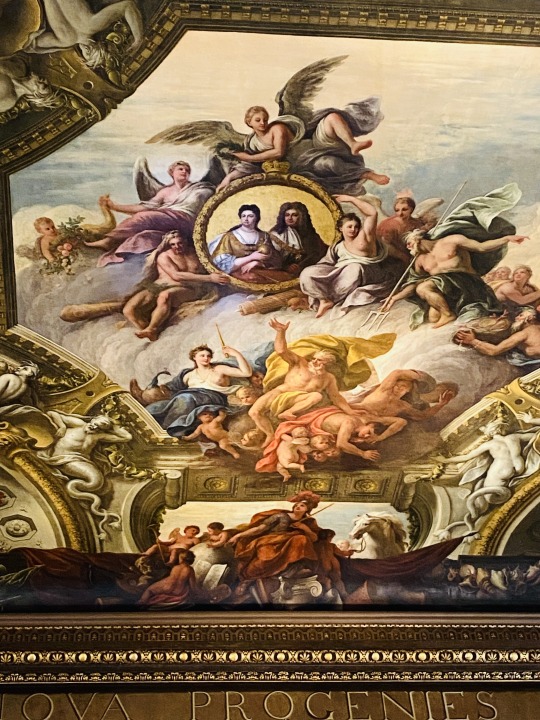
On the left of the upper hall is a depiction of William III’s arrival in England at the start of the Glorious Revolution in 1688, while George I is shown arriving on the opposite side of the hall (rather unrealistically in a chariot) in 1714.
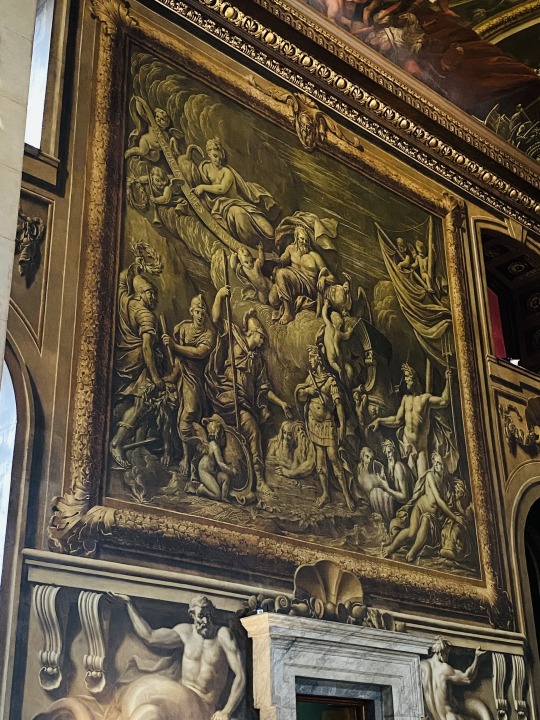
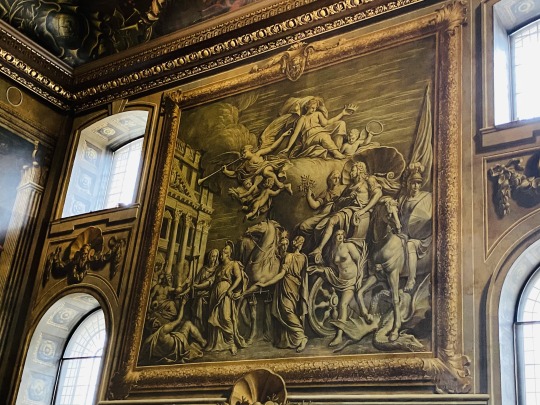
#painted hall#the painted hall#greenwich#history#british history#art#art history#william iii#william of orange#william and mary#george i#queen anne#17th century#18th century
137 notes
·
View notes
Text

Newby Hall in Ripon, North Yorkshire, is a stunning Georgian period country house, with some of the finest Robert Adam interiors around.
Newby Hall is a stately home located near Ripon in North Yorkshire, England. Built in the late 17th century, the house belongs to the Georgian ‘Age of elegance’. The house was designed by Sir Christopher Wren and later modified by John Carr and Robert Adam, the latter adding the renowned Georgian neoclassical interior designs. Newby Hall is set within extensive gardens, which include features such as a double herbaceous border, woodland garden, water garden, and a (brilliant) miniature railway. The hall and gardens are open to the public and serve as a venue for various events throughout the year.
8 notes
·
View notes
Text

St Pauls Cathedral, City of London
St Pauls Cathedral sits upon Ludgate Hill, the highest point within the City of London. A church has resided here since AD 604. The current St Pauls was completed in 1710, designed by Sir Christopher Wren following the Great Fire of London in 1666.
#london#england#photography#my photos#mobile photography#photographers on tumblr#original photographers#Original photographers on tumblr#church#city of london#cathedral#st pauls cathedral
7 notes
·
View notes
Text

…The previous January, Halley, Robert Hooke, and the architect Sir Christopher Wren had talked on after a meeting of the Royal Society. Wren wondered if it was true that the motion of the planets obeyed an inverse square law of gravity — the same inverse square relationship that Newton had investigated during the plague years. Halley readily confessed that he could not solve the problem, but Hooke had boasted that he had already proved that the inverse square law held true, and “that upon that principle all the Laws of the celestiall motions were to be demonstrated.” When pressed, though, Hooke refused to reveal his results, and Wren openly doubted his claim. Wren knew how tricky the question was.
- Newton and Counterfeit, by Thomas Levenson
4 notes
·
View notes
